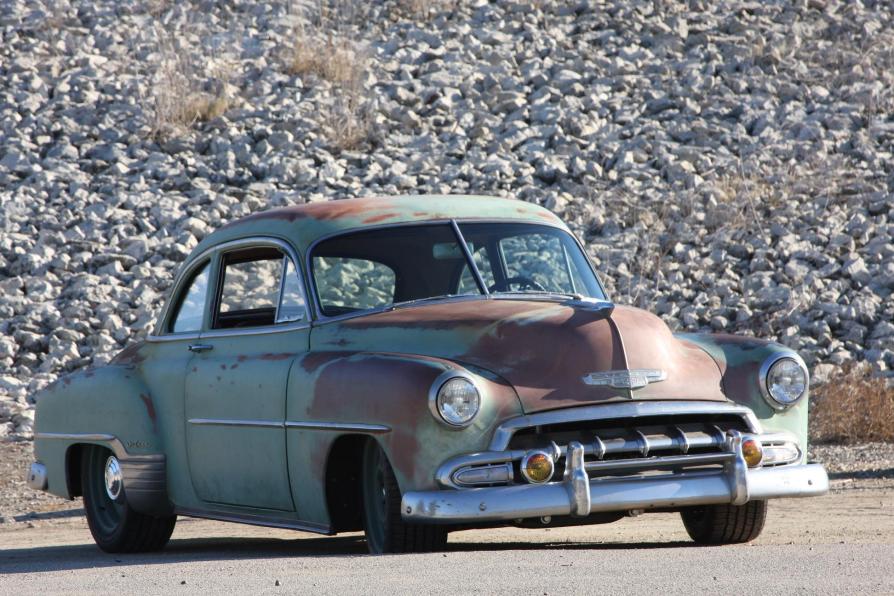News
It’s a Duesey!
News
It’s a Duesey!
“I’m obsessive compulsive,” he says over a cup of rather un-Californian mint tea. “I see a 3D model in my head and I have to make it or I’ll explode. To be able to take a project that’s been in my head for 15 to 20 years is just f**king mindblowing.”
Jonathan Ward built his business on retrofitting classic motors with modern parts and engines for power and reliability
It would be easy to assume that the Duesey is based on an off-the-shelf product, but this is a bespoke creation, designed by Ward in conjunction with one of the leading contractors in Switzerland. He chose a Dubois-Depraz automatic 14400 module and the luxe version of ETA’s 2892-A2 TOP base movement – although initially he had even hoped to design and build the movement himself.
“I wanted it to be made in America,” he says. “Then I got an education in watchmaking. I realise now that I don’t build my own engines because I don’t want them to blow up, so why would I try to build my own movement?”
Icon Duesey
Go your own way
“I had my first face-to-face with the contractors at Basel in 2016,” says Ward. “They seemed kind and accommodating. I’d already done the design and engineering – I’ve been thinking about this a long time – and I had a very clear idea of what I wanted. I think they sort of liked that – but they weren’t used to it. But I also found mechanical and material limitations that I didn’t know about, and that was hard to take.
“I’d designed the crown centre based on the Duesenberg wheel hub, and the case was inspired by an early thermosyphon radiator cap. I’d always been a jump hour kind of guy, and I’d always loved the early Duesenberg tachometer, though it wasn’t popular at the time – after the first 220-odd cars the owners and the chauffeurs said ‘no way!’, and later cars went to a more conventional design.”
Duesenberg’s dashboard tachometer that inspired the Duesey
Betting big
This is typical Ward. He gets an idea and he doesn’t let go of it until it’s absolutely right, even if that’s via unconventional routes. Even his business started from a quest to win a bet. It began with a friendly argument in 1996 with a college professor and a student on the laws of supply and demand, with Ward insisting that he could create demand by changing the supply chain. They disagreed – and agreed a $1,000 bet that Ward wouldn’t be able to prove his theory. Now Ward was at that point already a Toyota 4×4 enthusiast, and he was convinced that if he restored classic Toyota Land Cruisers (the 1960s competitor to Land Rover and Jeep) to the high standards of classic car restorations, then he would be able to create a whole new market.
“From my travelling antics I already had massive respect for the Land Cruiser,” he says. “But no one was giving them the respect of traditional classics. So I drove around the dry western states buying every FJ40 [Land Cruiser] I could find. I took them to the mechanics shop and the paint shop that I was already using and we turned them around. They flew out the door. I went back to the college to reclaim my $1,000 bet but I couldn’t find the student and the professor said he’d just been joking.”
“FJ” model offered by Ward’s company
As their success grew, they started to realise that there was a market for the classic Toyotas using modern mechanical parts under their 1960s and early 1970s bodywork, and so in 2007 the Icon branch of the company was born.
Icon’s range still includes the Toyota Land Cruisers as well as the 1960s Ford equivalent, the Bronco, and it has also expanded into those now-famous Derelicts – almost always based on the American land yachts of the 1950s, looking for all the world like barnfinds but with reliable, powerful modern mechanical parts underneath.

Derelicts restored
So, what next? Ward grins. “There’s so much cool shit going on. On the watches I’m choosing between three possible new designs. I can’t tell you too much – but last night I couldn’t sleep so I worked out the colour palette.”
More details on IconWatchCompany.com
Movement
Dubois-Depraz automatic14400 module with ETA 2892A2 TOP base movement, jumping hours, minutes disc
Case
42mm sandblasted titanium grade 2
Strap
Alligator leather strap with turned edges, no stitching, with black calf leather lining
[/td_block_text_with_title]










